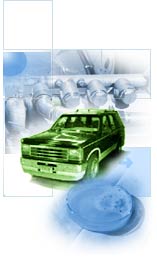
CSA MESSAGE | PATENT PORTFOLIO | WHITE PAPER - HYDROGEN ON DEMAND™
SYSTEM |  WHITE PAPER - BATTERIES
WHITE PAPER - BATTERIES
Boron-Based Batteries
Millennium Cell
has patented processes to directly extract electricity from certain
boron-based compounds. These processes are based on direct
electro-oxidation without release of hydrogen. For borohydride
anions, the chemistry of this reaction is as
follows:
BH4- + 8 OH- —› BO2- + 6
H2O + 8 e- (1)
This reaction can take place at an
electrode inside a typical disposable battery. On the right side of
the equation, electrons are shown (as e-). The electrons move
through an external circuit and provide electrical power to a wide
range of electronic devices. To complete the electrical circuit,
another electrode, called a cathode, must accept the electrons. Air
can be a cathode. It uses oxygen as a final place for the electrons
released from borohydride. The chemical equation at an air cathode
is written:
8 e- + 4 H2O + 2 O2 —› 8
OH- (2)
The eight electrons that are shown on the left side
of this reaction originate from the right side of the reaction (1).
Thus, the circuit is complete and reactions (1) and (2) form the
battery chemistry.
BH4- + 2 O2 —›
BO2- + 2 H2O (3)
In an actual sodium
borohydride battery, all of the negatively charged borohydrides
(BH4-) and all of the negatively charged borates
(BO2-) are balanced with positive sodium atoms (Na+) and
the final reaction is:
NaBH4 + 2 O2 —›
NaBO2 + 2 H2O (4)
This is a very
energetic reaction, and also the components are very light in
weight. For these reasons Millennium Cell is developing prototype
batteries with promising performance characteristics.
Millennium
Cell is also developing prototype batteries from a family of
boron-based compounds called borides. A representative example is
titanium diboride which, when coupled with an air electrode, has the
overall reaction:
2 TiB2 + 5 O2 —› 2
TiO2 + 2 B2O3 (5)
The
reasons why this battery is so promising are tabulated below in a
comparison of Free Energy:
Free Energy = n · F ·
E
Where n is the number of electrons (in moles) exchanged in
the electrochemical reaction, F is a number called Faraday's
constant, and E is the battery voltage.
|
Battery Material |
n (moles of electrons) |
F (C / moles of electrons) |
E (V) |
Free Energy (kJ)
|
|
Zinc |
2 |
96485 |
1.25 |
241
|
|
Sodium Borohydride
|
8 |
96485 |
1.24 |
957
|
|
Titanium Diboride |
10 |
96485 |
1.8 |
1,737 |
Zinc is the
metal typically used in commercial batteries. In comparison,
boron-based batteries are potentially several times better than zinc
batteries. The reason is the number of electrons exchanged per
reaction. Real life is never as simple as calculations show,
however, and the example boron-based battery chemistries from the
table suffer some negative factors. The good news is that even when
these things are factored in, boron-based batteries can still last
twice as long as traditional batteries.
Borohydride Fuel Cell
Millennium Cell has
also patented a borohydride fuel cell. This is a device that
contains the best aspects of the borohydride battery and the
Hydrogen on Demand™system. The hydrogen generator stores a great
deal of energy in an easily handled liquid. The borohydride battery
is a high efficiency energy conversion device. The borohydride fuel
cell is a high efficiency energy conversion device using an energy
dense, easily handled liquid fuel.
The overall
electrochemistry of a borohydride fuel cell is the same as for the
borohydride battery.
NaBH4 + 2 O2 —›
NaBO2 + 2 H2O (1)
The main difference
between borohydride fuel cells and borohydride batteries is that
fuel cells generate electricity and batteries store it. In the case
of a battery, all of the borohydride fuel it has available is
present in the system at the beginning. When that fuel is spent, the
battery is dead. On the other hand, a fuel cell stores its fuel away
from the electrode, ideally in a form that is easily replenished. As
long as the fuel is supplied to the fuel cell, it will continue to
operate. Even if a fuel cell runs out of fuel, it can be restarted
again when new fuel is provided.
The chemistry at the
electrode for the borohydride fuel is
BH4- + 8 OH-
—› BO2- + 6 H2O + 8 e- (2)
The cathodic
(air) electrode reaction is
8 e- + 4 H2O + 2
O2 —› 8 OH- (3)
which draws its fuel directly from
the oxygen in air.
The advantage of using the borohydride
battery chemistry in a fuel cell instead of PEM fuel cell chemistry
(½H2 + O2 —›H2O) is the possibility
of extracting more usable energy from the same amount of fuel. In
other words, more energy is obtained from the same fuel, and the
borohydride fuel cell can be refilled and used over and over
again.




